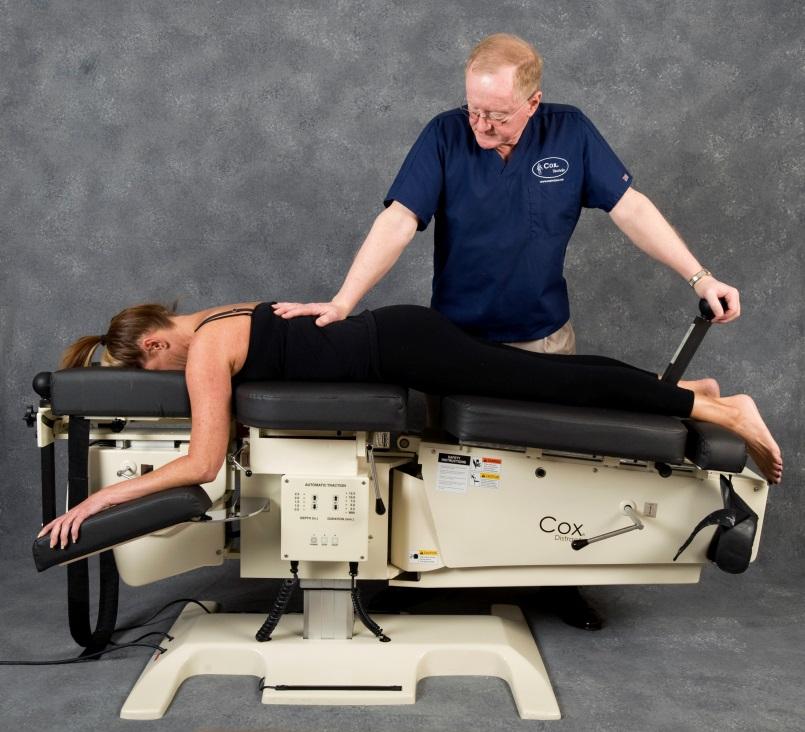By Julie Cox-Cid
In the 1000 cases study of patients treated with Cox Technic Flexion Distraction protocols, spondylolisthesis responded well, but did take a few more visits of extremely gently applied manipulation for relief. Its back pain sufferers appreciate gentle, non-surgical options to attain relief. Spondylolisthesis at the L4 level, usually of degenerative origin, saw 45% of the cases attain maximum improvement in 1 to 20 visits, 24% in 21 to 30 visits with 31% treated more than 30 visits. Spondylolisthesis at the L5 level (most commonly of pars interarticulares defect origin) found 74% attained maximum improvement in less than 20 visits and the remainder treated more than 20 visits. 95% responded in less than 90 days, the marker connoting the crossover to a chronic pain condition. (1) Chiropractic helps spondylolisthesis, and Cox Technic flexion distraction offers protocols to relieve spondylolisthesis pain and help them avoid the battle with a chronic pain condition.
DESCRIPTION
A pathological condition described as a slipping of one vertebral body on the one below it, spondylolisthesis results from structural and/or degenerative changes of the spine. (3) Now, the cause may be due to a stress fracture in youth, an old sports injury or a new one; pain may be due to a new slip or degeneration of a disc. The slip may be stable or unstable. The stable ones respond better, as shown in a ten patient study which revealed 75% of stable spondylolisthesis cases were relieved of pain with Cox® Technic Flexion Distraction. (2) Fortunately, unstable spondylolisthesis, meaning that the slip is more than 3 mm, is not as prevalent. Regardless, chiropractic flexion distraction relieves resultant back pain from spondylolisthesis for many lower back pain patients.
TREATMENT PLAN
The chiropractic flexion distraction treatment plan involves both the doctor and the patient. The doctor must, of course, diagnose the condition properly and determine if it is a stable or unstable. Then the chiropractor will proceed with very gentle flexion distraction tolerance testing, noting any lateralization of pain. Once it is determined how the patient will be treated with flexion distraction – cuffs, no cuffs, ankle contact or tiller bar contact – treatment is initiated. Typical flexion distraction travel distance is just 1” to 2” from the treatment start point. (4) However, the rule in treating spondylolisthesis is always “less is more.” Less force is best. Less velocity is best. Less traction is best. Sometimes even treating this patient in the side-lying position is preferable, using the flexion distraction table’s lateral flexion ability to elicit flexion and the table’s flexion ability to elicit lateral flexion. Having a pillow bolster under the patient during the treatment may enhance care. It certainly minimizes the amount of force necessary to apply the manipulation. (4)
Following the flexion distraction treatment, physiotherapy modalities like low volt galvanism, tetanizing current, hot/cold/hot can support the treatment. A back brace with memory foam that molds around the spinal elements to hold them in place is important in the beginning of care. Nutritional supplementation to support the vertebrae of the spine and the discs, particularly such with chondroitin sulfate from a source like perna canaliculus which also has anti-inflammatory properties, is helpful. Patient cooperation with these ancillary treatment and lifestyle-incorporating recommendations is vital, especially when it comes to exercise.
Spondylolisthesis patients most often have tight hamstrings. Exercises designed for them to gently stretch their hamstrings are crucial. Tight hamstrings shift the workload to the spine which does not need that extra stress when spondylolisthesis is involved.
The flexion distraction system of care designed by Dr. James M. Cox and followed by so many chiropractic physicians offers such patients a non-surgical approach to contain their condition and offers chiropractic physicians a reliable, research based system to help control these patients’ pain.
Julie Cox-Cid is the co-ordinator for Cox Technic Flexion Distraction. She can be reached at juliecoxcid@coxtechnic.com or via the website at www.coxtechnic.com .
References:
-
Cox, JM, Feller JA, Cox JA: Distraction Chiropractic Adjusting: Clinical Application, Treatment Algorithms, and Clinical Outcomes of 1000 Cases Studied. Topics in Clinical Chiropractic 1996; (3)3:45-59, 79-81
-
Cox JM, Trier K: Chiropractic adjustment results correlated with spondylolisthesis instability. J of Manual Medicine 1991;6:67-72
-
Ferrari S, Vanti C, OReilly C: Clinical presentation and physiotherapy treatment of 4 patients with low back pain and isthmic spondylolisthesis. J Chiropractic Medicine 2012; 11(2):94-103
-
Cox JM: Low Back Pain: Mechanism, Diagnosis, Treatment. 7th edition. Philadelphia: Lippincott Williams and Wilkins, 2011. Chapter 11.